SEM is an acronym for search engine marketing. In French, it means marketing for search engines. It refers to all the strategies you put in place to increase the visibility and traffic of your website in search engines. That is to say, everything you do to promote your site on the Internet. SEM thus encompasses the practices of natural referencing, those of paid advertising and to some extent, those of optimization of sites for social networks
93 % of Internet users start their experience from a search engine
This statistic shows that you can’t survive on the internet if you don’t develop a strategy to optimize your site for search engines
Also, knowing that 60 % of Internet users click on the first three search results, it is important to work to get your site to appear in that ranking
To achieve this, there are many optimization strategies that can be put in place
All these strategies can be grouped under the name of search engine marketing (SEM).
In this article, I talk about search engine marketing.
So follow along!
Chapter 1: What is Search Engine Marketing?
In this first chapter, I explain what search engine marketing is, its components and the importance it has for your website.
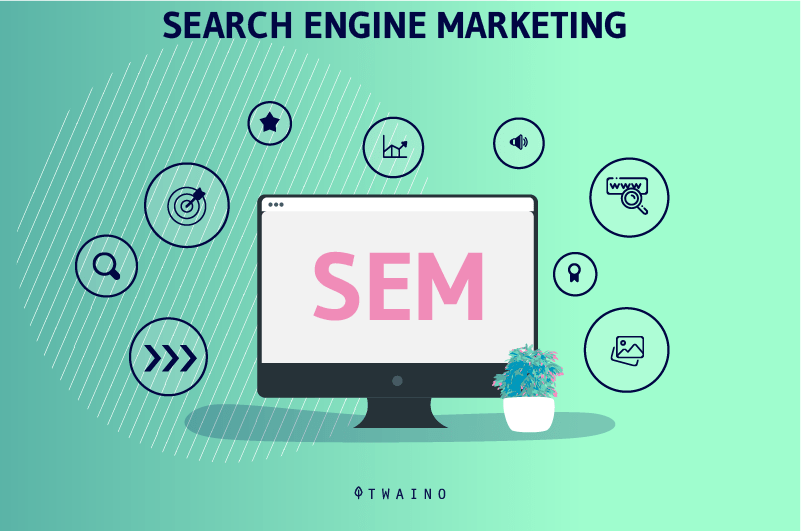
1.1 What is SEM?
To better understand the meaning of the term Search Engine Marketing, we need to understand what marketing actually means
As you know, marketing refers to everything you do to promote your business and generate interest in the products and services you offer.
From there, search engine marketing refers to the strategies you put in place to promote your site on the internet
Indeed, once webmasters determine the most relevant keywords for their site, they not only optimize their content on these keywords, but also, they search these keywords by creating targeted advertisements.
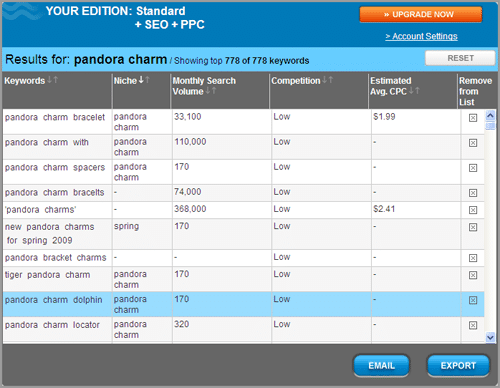
Source wordstream
Then, when a user types a query with the keyword into the search bar, the search engine displays ads and organic content that are optimized for that keyword.
SEM therefore includes natural referencing and paid advertising
However, it can be extended to include optimization for social networks because of their evolution and importance and because they are increasingly used as real search engines.
However, even though SEM encompasses natural search engine optimization (SEO), paid advertising (SEA) and social media optimization (SMO), it is important to remember that there are differences between each of these optimization techniques
1.2. The components of SEM and their specificity
The main objective of SEM techniques is to promote your website, but also to attract visitors.
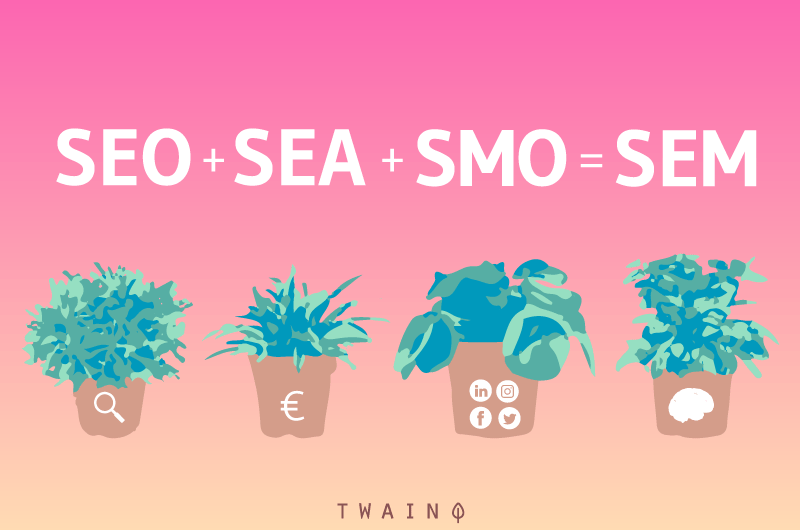
SEM encompasses several optimization strategies, namely
- The search engine optimization or natural referencing
- The search engine advertising or Search Engine Advertising;
- Social media optimization.
Each of these techniques is different from each other.
1.2.1. The SEO
SEO can be defined as the set of techniques that you put in place to ensure that your site is displayed at a good position in organic search results
It allows you to make your site perform well in order to get free and important organic traffic
The various SEO practices can be divided into two main categories
- On page SEO on page SEO refers to all the practices that you apply on your site to make it perform better in the SERPs;
- The off page SEO off-page SEO refers to everything you do outside your site to improve its ranking in search results
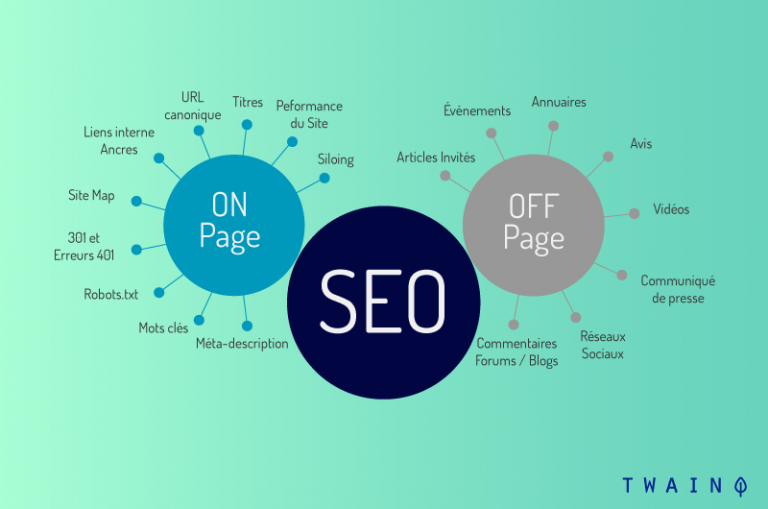
Similarly, SEO techniques are often grouped into several categories namely
- Black hat SEO ;
- White hat SEO;
- Gray hat SEO;
- Dunce Cap SEO.
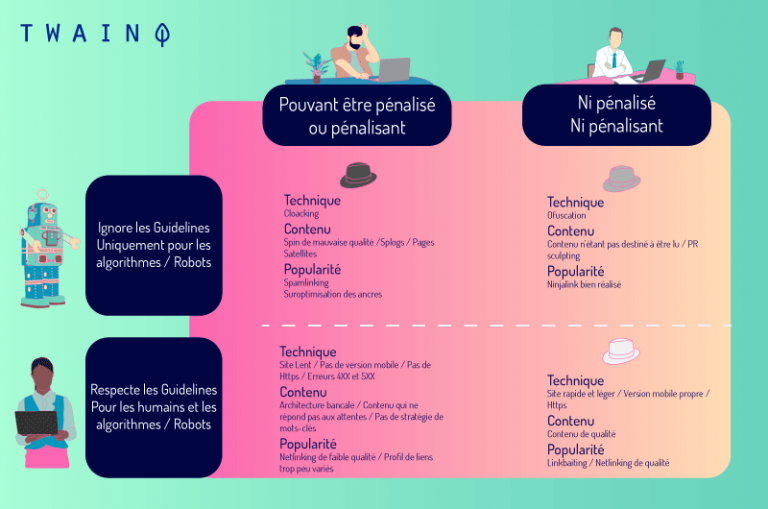
Regarding the advantages of SEO, you can remember that the performance obtained through SEO is achievable at a lower cost, or even free
Also remember that the results of SEO are long term and often consistent
Also, the different SEO techniques, especially those that are done on the page, contribute to increase
- Usability
- Accessibility;
- And the technical performance of your site.
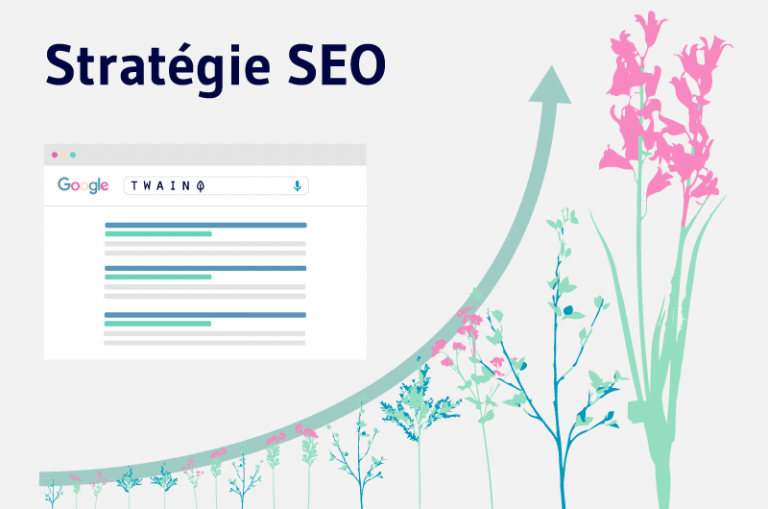
But despite all these performances, it should be remembered that SEO practices alone are not enough to bring a site to its maximum performance. This is because of the limits they present
Indeed, despite the advantages of SEO, you must keep in mind that SEO practices are technical
Their implementation requires time and the results do not necessarily appear overnight
It is actually a long process that requires time and effort, but also, a perfect knowledge of SEO tactics. That said, once the results appear, they last in the long term.
1.2.2. SEA
Unlike SEO, SEA refers to the set of practices that allow webmasters to optimize their site from paid advertising.
These ads are usually displayed at the top of SERPs and are preceded by the words “ad”
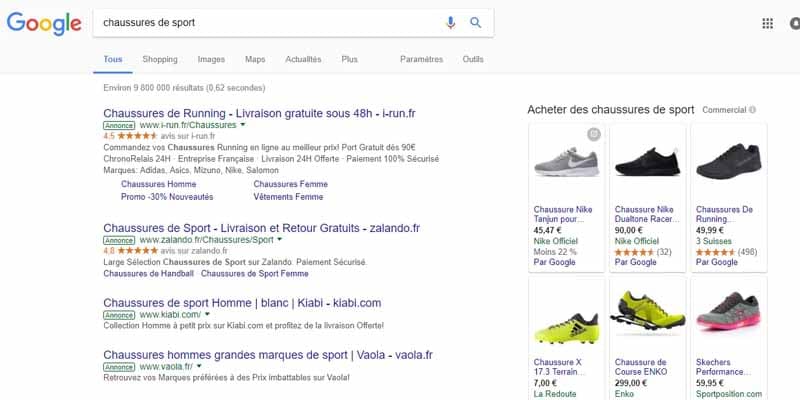
One of the objectives, which the SEA pursues, is to quickly make your site visible in search engines
Indeed, the SEA is a marketing strategy that essentially allows a website to increase its click rate as well as its conversion rate
It is a strategy that includes activities such as
- The configuration and optimization of advertisements on dedicated platforms
- Setting up a budget that pays for the placement of ads.
As far as the advantages are concerned, the SEA allows you to
1.2.2.1. Strengthen your brand awareness
According to Google, ads can support your brand awareness up to 90 %.
Brand awareness refers to the way users perceive a brand
It can also mean that it is known and recognized by a large majority. SEA tactics allow you to achieve this goal
Indeed, by implementing different SEA strategies, you can make your site a credible place where users find the information and products they are looking for.
SEA strategies also allow you to increase your online presence
This online presence translates into many leads. This in turn allows you to sell your products and services and earn money.
1.2.2.2. Increase your revenue
SEM strategies give businesses more chances to earn money
Moreover, you should keep in mind that SEM tactics improve your conversion rate
This is because your paid ads are linked to landing pages or sales pages that have the role of converting and getting people to make purchases
1.2.2.3. ATS is effective for local marketing
The purpose of local marketing is to share your company with your immediate surroundings.
That is, to allow people around you to find the products and services you offer.
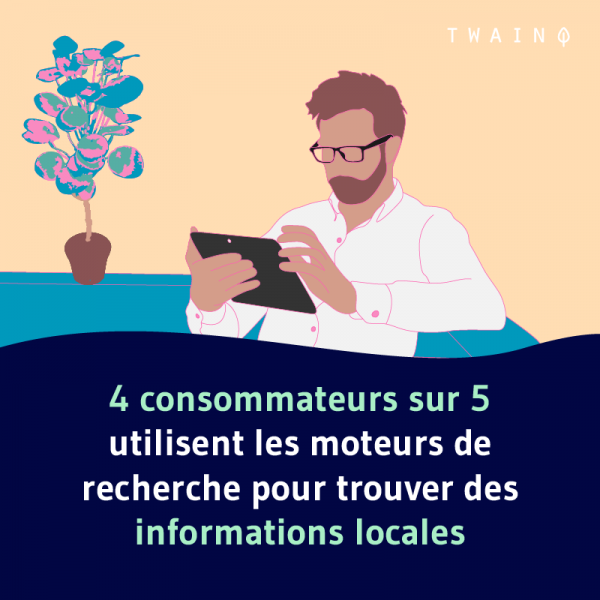
And rightly so, 4 out of 5 consumers use search engines to find local information.
1.2.2.4. SEA tactics allow you to get instant results
Unlike SEO strategies that take several months to show results, advertising campaigns or paid ads have the advantage of generating results very quickly
This is because once you configure and put your paid ads online they are operational.
1.2.2.5. Getting qualified leads
As you know, it is not enough to just get traffic. The important thing is to get the right traffic
But unlike SEO which does not allow you to control the people who will see your site, SEA allows you to access the audience that will need to interact with your content
The possibilities you have to target specific data and exclude keywords ensures you get qualified traffic for the objectives you are pursuing
1.2.2.6. SEA is a way to appear in first position
Because ads are mostly displayed at the top of organic search results, setting up paid ads gives you a better chance of being at the top of the SERPs
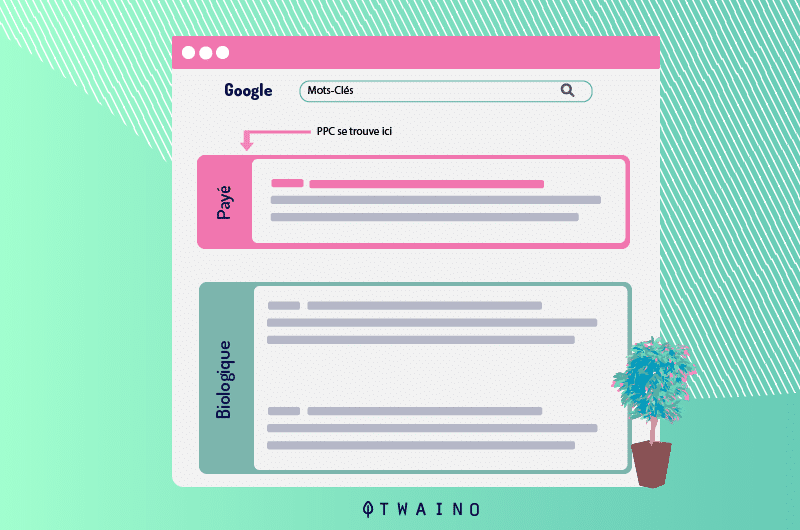
1.2.2.7. Understanding search intent
The analysis of the data that you will collect from the PPC campaigns that you have set up allows you to extract useful information concerning what the Internet user is looking for on your site
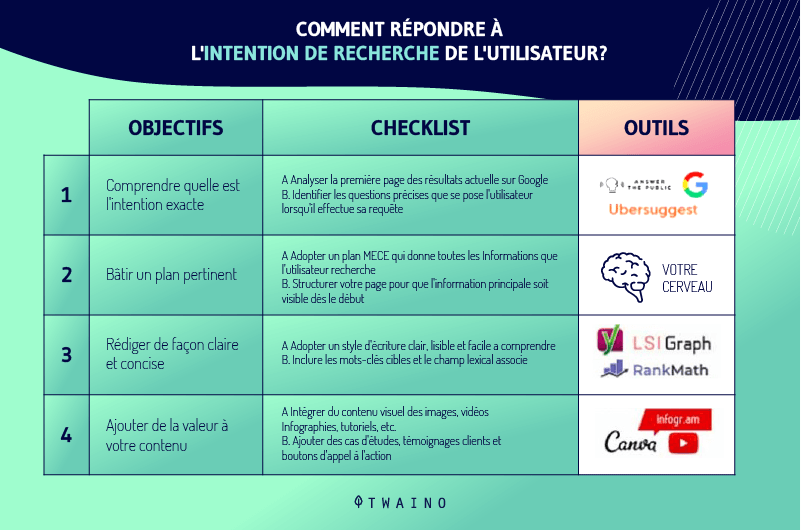
However, in terms of limits, keep in mind that SEA strategies are determined by the advertising campaigns that you set up as well as your budget
1.2.3. The SMO
Social Media Optimization is an SEO technique that does not focus on search engines like SEO and SEA, but rather on social networks
This is justified by the importance and the place that social networks occupy today in our lives
Indeed, with several billion visits per day on social networks, it is obvious that you should not exist on the Internet without developing a presence on social networks
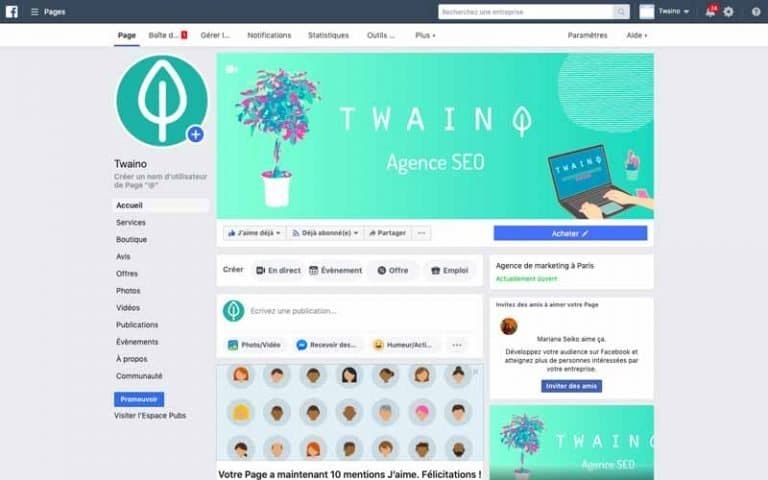
Thus, the set of SMO techniques focuses on how to create and develop your presence on social networks to attract visitors to your site
Concretely, this is done in two places
- At the site level by setting up social sharing buttons, links to your social profiles;
- Outside the site on social networking platforms
The use of social media optimization strategies allows you to
- Encourage social network users to visit your website
- Interact with potential customers;
- Carry your message to potential customers;
- Build and develop an online reputation around the products and services you offer;
- Build a community of people interested in what you do and willing to share their opinions or ideas with you;
- And so on.
However, like SEO and SEA, social media optimization also has its limitations
These limitations range from how people may react to certain posts, to the difficulties you may have in finding a good audience
Whether it’s SEO, SEA, or SMO, they certainly have the same goal, but they are not the same
Despite their limitations, they all complement each other and seem to be necessary to reinforce each other
Indeed, a good search engine marketing strategy must take into account SEO, SEA and SMO strategies
This is precisely the idea behind the equation: SEM = SEO + SEA + SMO
1.3. How important are search engine marketing strategies for your website?
As you can see, SEM is a diversified marketing channel on the Internet.
With nearly 81,000 searches per second, companies and websites have understood its importance and are eager to implement the strategies it covers
SEM indeed gathers various optimization techniques which have both advantages and shortcomings, but which also complement each other.
To better understand its importance, we need to start from the way search engines work

Today, search engines are more and more sophisticated
They can
- Understand human language, learn automatically;
- Process, sort and classify information.
Also, they no longer just display results that match the user’s queries, but rather display the best results that match the user’s query
This is due to the numerous criteria that exist and that govern the display of a site’s content in the search engine results
Compliance with these rules requires obedience to certain practices and conduct that are known as SEO strategy.
But nowadays, the strong competition that exists between websites coupled with the limitations of SEO has led to the development of other strategies.
These are SEA and SMO
SEO and SEA are strategies that can be implemented at the search engine level
The SMO is essentially implemented at the level of search engines, but they all pursue the goal of website visibility
Now that you know what SEM is and its importance for your website, discover how to set up a good SEM strategy
Chapter 2: How to set up a SEM strategy: Know the basics
As you can imagine, the implementation of an effective SEM strategy must take into account all the components of search engine marketing, namely
- Search engine optimization ;
- Social media optimization;
- Search engine advertising
But before we go any further, it would be interesting to know some essential elements
2.1. The basics to know
Before actually implementing SEM techniques, you must first master a few basics
2.1.1. The fundamentals of SEO
Search engine optimization or natural referencing allows you to optimize your site so that it appears in the organic results of search engines.
You don’t have to pay to take advantage of these strategies. However, in order to succeed you must respect a certain number of rules
In concrete terms, search engine optimization aims at ranking your site in the SERPs
This ranking is favored by respecting the google guidelinesguidelines, but also by the identification of your site as better by Google
This is done through the implementation ofalgorithms quite powerful.
These algorithms use several criteria to verify that your site respects the recommendations of the search engine and corresponds to the search intention of Internet users
Anyway, when you want to implement a good SEO strategy, you must
- Know the SEO Jargon;
- Learn and implement a watch to know the best SEO practices that work
- Make sure your site can be easily crawled and indexed by Google
- Define your target audience and the goals you would like to achieve with your site
- Find the right keywords to optimize your content;
- Create quality content;
- Analyze your competitors;
- Regularly audit your site and follow the results
You can use my blog to learn all these notions or buy my ebook about SEO for beginners.
2.1.2. The basics of SEA
SEA is not that far from SEO. In fact, the biggest difference here is that you have to pay to have your site appear in the search results
Search engine advertising involves a number of specifics that you need to know
These specifics concern
2.1.2.1. SEA platforms
Is qualified as a SEA platform, a search engine at which you can create your advertisements.
These advertisements appear each time the Internet users use in their requests the keywords of commercial intention on which you decided to create your advertising campaign
The most commonly used SEA platforms are
- Google Ads ;
- Bing ads ;
- Yahoo Ads ;
- Etc.
2.1.2.2. The SEA keywords
The SEA keywords are terms and expressions on which you target your advertising campaigns
The keywords used at this level can be classified in 4 categories namely
- The keywords for large queries these are keywords that you use to target variations of a term. It includes similar phrases or synonyms of the search term, you can also think of using a plural or singular form of the term;
- Matching keywords this is where you target words that are closely related to your target keyword
- The exact keywords the exact keywords are words that are closely related to your keyword with the same research intention;
- Negative keywords negative keywords: These are terms that you do not want to target. You will therefore have to exclude them.
2.1.2.3. SEA targeting
It tells the SEM platforms when to show your ads. You can also define your parameters to know the exact moment of this broadcast and the person to whom it was broadcast
You will see several kinds of targeting
There are for example
- Geographical targeting you can define the areas from which your ads should be seen;
- Calendar targeting this is when you create ads and configure them to be displayed at a specific time
- Demographic targeting this is the possibility to set up ads to be displayed to a specific category of people
- Device targeting at this stage, you set up ads to be displayed to users who use specific devices;
- And so on.
2.1.2.4. The structure of an ATS account
Another thing you need to know is the structure of your ATS account or platform.
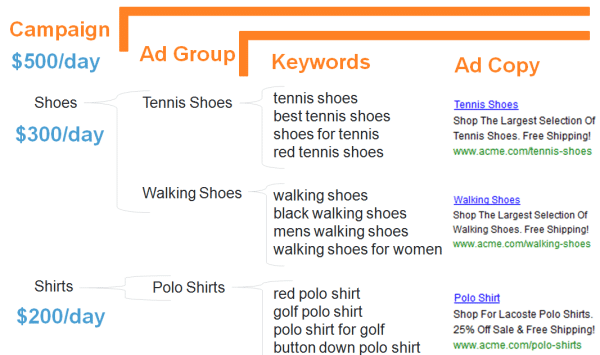
Source Hubspot
The structure of an account for advertising is as follows
- Campaign;
- Ad groups;
- Keywords and ads.
Campaigns
You can choose the type of advertising campaign you want to run from your platform.
There are several options for each campaign. Each campaign is aligned with a different business objective
Ad groups
Ad groups are located under campaign
Within the ad group, you can for example organize your keywords as well as the ads according to a general theme or idea
Keywords
Keywords are the words that people will type in the search results to trigger the ad
It is important to look for the most profitable keywords related to your product or service and apply them to your ads
The ads
Ads are what are displayed on the SERP when a consumer uses your keyword
You have various types of ads besides text ads. These are:
- AdWords ;
- Display ads: These are banner ads that are displayed anywhere on sites or applications;
- Re-targeting ads: They are displayed on other websites according to the searches made by the user;
- Google shopping ads;
- Etc.
The ranking of the ads is generally done according to the amount of the bids. Therefore, if you are the highest bidder, you will appear above all other ads.
2.1.2.5. The ad bidding at the SEA level
Before your ad appears in the search results, you must enrich the keywords.
When you enrich a specific keyword, your ad will appear when someone searches for that keyword.
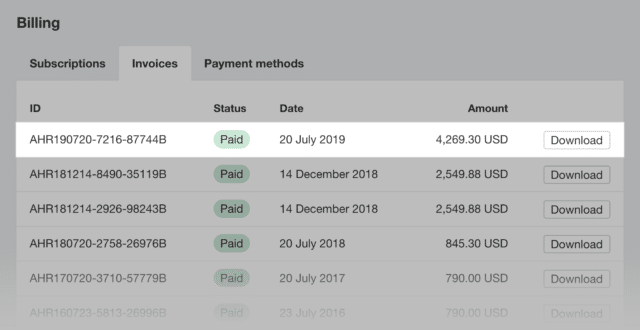
Source Backlinko
To enrich, companies provide the search engine with
- The maximum amount they are willing to pay for a keyword;
- The copy of the ATS ad;
- The landing page the consumer will go to if they click on the ad.
The search engine takes this information and compares it to the bidding information of other companies
The company that will have
- The highest bid;
- The highest quality landing page;
- The ad with the highest expected impact wins the auction.
2.1.2.6. Other ATS terms to know
- Quality score the quality score is the score that the search engine gives to the ads that your company creates. This score is determined by several factors. It is essentially the click rate and the quality of your landing page;
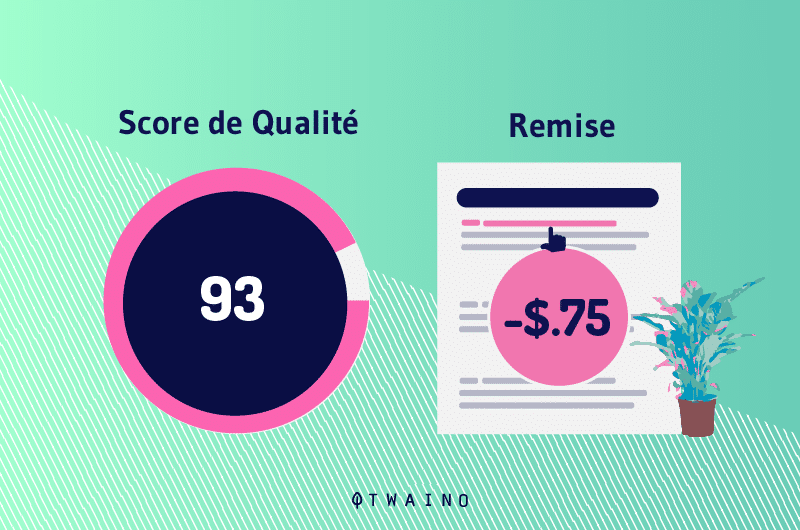
- The click rate the click-through rate is the number of times a user clicks on your ad after having seen it.
- The value of the keyword the value of a keyword is what allows you to know if the keywords associated with each of your ads are effective or not. This is determined by the click-through rate.
- Landing page quality: The goal of search engines is to offer the best products to their users. The landing page for each ad you create must be designed with this goal in mind. If it is of good quality, your quality score will be positively impacted but also, it will impact the price your company will pay for these ads. In fact, sites with high quality scores pay less than those with low quality scores.
2.1.3. The fundamentals of SMO
In the same way that a potential customer comes across your site in search results, they may learn about you when they visit you on social media
As a company trying to be visible on the internet, you can’t leave social networks aside.
This is justified by the many statistics about the impact of social networks on marketing
These include the fact that
- 2.4 billion internet users are on Facebook;
- 10,71 % of the total audience is reached on average by a publication
- Posts on Instagram have an average engagement rate of 2,2 % ;
- Etc.
Social media optimization or search engine optimization refers to the improvement of your presence on the best social platforms such as
- Facebook ;
- Twitter ;
- Youtube ;
- Etc.
When you decide to consider this strategy, you should follow these tips
- Create content that elicits sharing at the social network level;
- Make it easy to share this content on social networks;
- Recognize and thank your community when they engage with your content
- Encourage discussion;
- Pay attention;
- Know and use promotional tools;
- Getting people to find you on social networks by setting up a consistent social profile and presence.
- Set up social sharing buttons and links to your social media contact information
To learn more about social media optimization, I invite you to check out this comprehensive guide from Hubspot.
Now that the basics of each optimization technique have been explained, here’s how to set up a good search engine marketing strategy
Chapter 3: How to set up a good search engine marketing strategy?
To implement a good search engine marketing strategy, you can follow these steps
3.1. Define your goals
Implementing a search engine marketing strategy should not be done on a whim
You must first define the goals you want to achieve with such a strategy
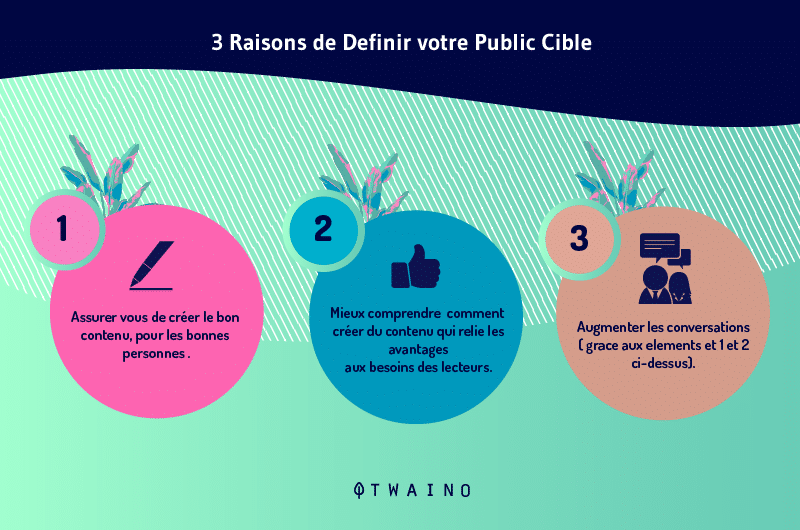
In general, the implementation of a search engine marketing strategy aims at
- Increasing your organic and paid traffic;
- Improving your conversion rate;
- A high ranking in the SERPs;
- Etc.
3.2. Define your target audience
If you want to implement a proper SEM strategy, you must first identify your target audience
The target audience is defined as the group of individuals to whom you wish to address your products or services
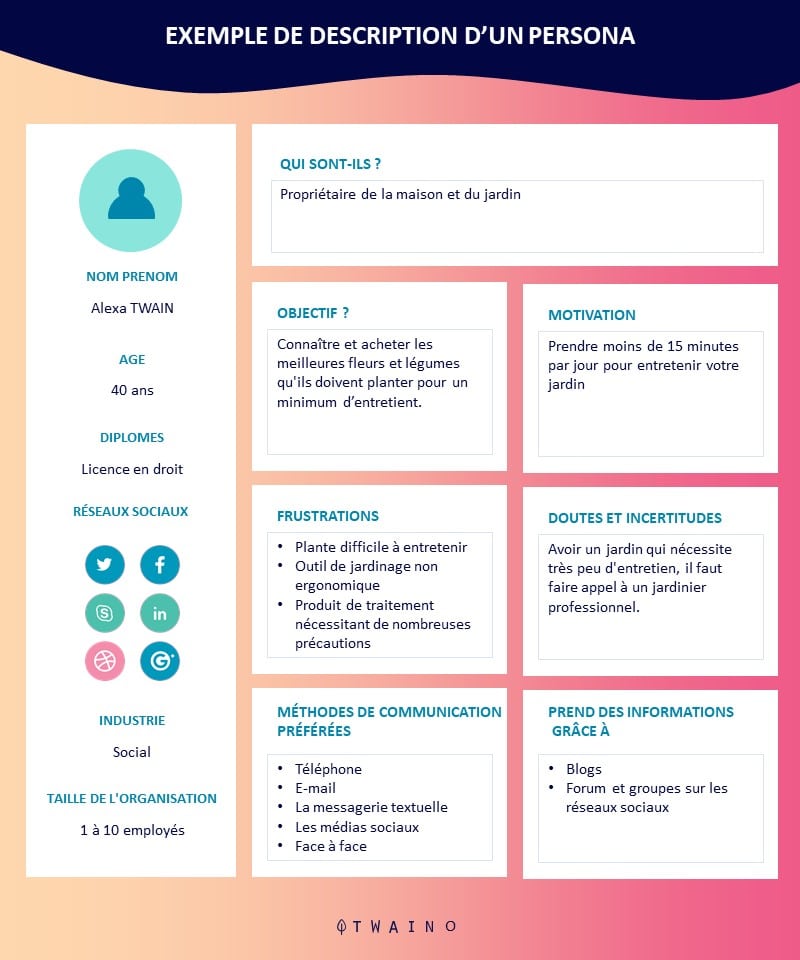
Identifying your target audience will include determining the characteristics of that audience, but also identifying what their real needs are and how to go about converting them.
3.3. research the right keywords
Once you have defined your target audience and whatever types of techniques you plan to use, you need to conduct keyword research
Keyword research will allow you to find relevant phrases and words that your target audience frequently searches for
To be effective, keyword research should be done in three steps
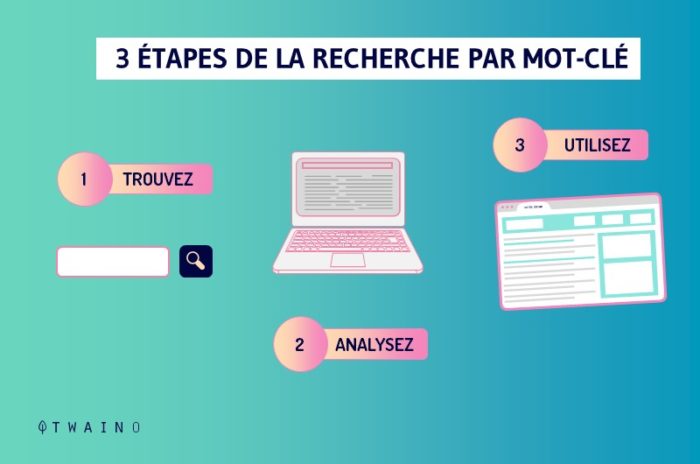
First, you need to build a list of keywords that you think are relevant to your site
These keywords should be chosen based on their search volume.
Then, you should analyze this list of keywords in order to keep those that are really relevant
Such an evaluation will have to be guided by the search intention of the Internet users, but also, to be carried out on the basis of certain indicators which are
- The click rate;
- Search volume;
- The difficulty of the keywords;
- Etc
Finally, the last step is to use them well on your site
If you want to better understand each of these steps, I suggest you visit the complete guide to keyword research
3.4. Create quality content
Whether you are in organic search, paid ads or social media, content is an essential element that you must take into account when implementing your strategies.
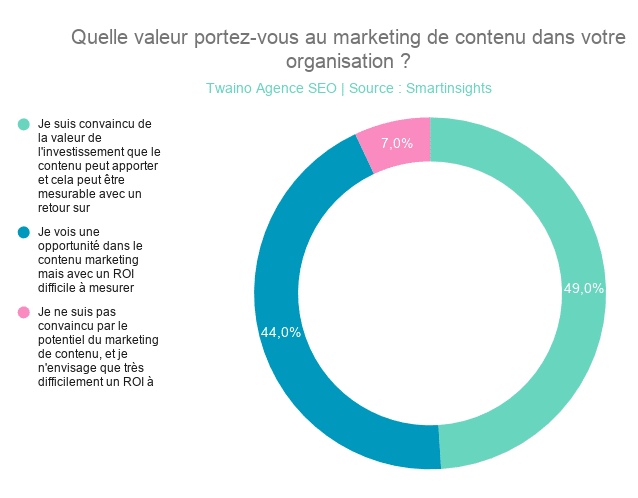
Google has already notified this and this is what justifies the existence of the quality guidelines it has issued to webmasters
Quality content must be well written, contain keywords naturally dispersed in the text and contain no grammatical or spelling errors.
It is also this content that allows you to satisfactorily respond to the request of the Internet user
Discover in this article how to create quality content on your website
3.5. Create a relevant landing page
Once you’ve selected your keywords and written your ad content, it’s now time for you to create the landing page and optimize it to attract users.
If your ad content is attractive and well designed, your landing page should do the rest.

Then, when a user lands on your site thanks to this ad, you will pay for the click
The least you can do at this point is to make sure you do everything you can to turn that click into a conversion.
Aside from that, you should also avoid putting anything on your landing page that might distract the user from your call to action.
3.6. Optimize the technical performance of your site
The technical performance of your site also plays a role in its ranking in search results
Indeed, beyond actions such as keyword research or the creation of quality content, you must also take into account the performance of your site
This includes for example
- The loading speed;
- The creation and implementation of tags;
- The different design codes of the site;
- The security of the site;
- Usability;
- the adaptation of the site to the mobile display;
- And so on.
Despite these general actions, you can focus on each of the tactics that are more specific to each type of optimization
For SEO, I invite you to consult the complete guide to an SEO campaign
Regarding SEA strategies, I recommend you read this guide on Google ads
Finally, for social media optimization strategies, I recommend reading this article from Hubspot on the steps to follow to create an SMO strategy
There you have it, everything you need to implement a good SEM strategy
However, note that implementing a good SEO strategy is not just a list of actions to take
Because once you have your strategy in place, you need to find out if it is working or not. To do this, set up and implement performance indicators
These indicators will allow you to collect information about the growth or decline of your site
Then, from this information you can identify with much more efficiency the difficulties you encounter in order to find the appropriate solutions
The indicators to put in place depend on the objectives you are pursuing
To know which indicators to put in place, consult my previous article on the Essential SEO KPIs.
In summary
Search Engine Marketing (SEM) is the set of activities formed by :
- Natural referencing ;
- Paid advertising;
- Social media optimization
It involves a series of tactics and strategies that have as their main objective the visibility of your site in search results.
In this article, I have explained what search engine marketing is, its components and the importance it has for your website
To complement this article, I also suggest you read Don’t get confused anymore between SMO = SEO + SEA + SMO.

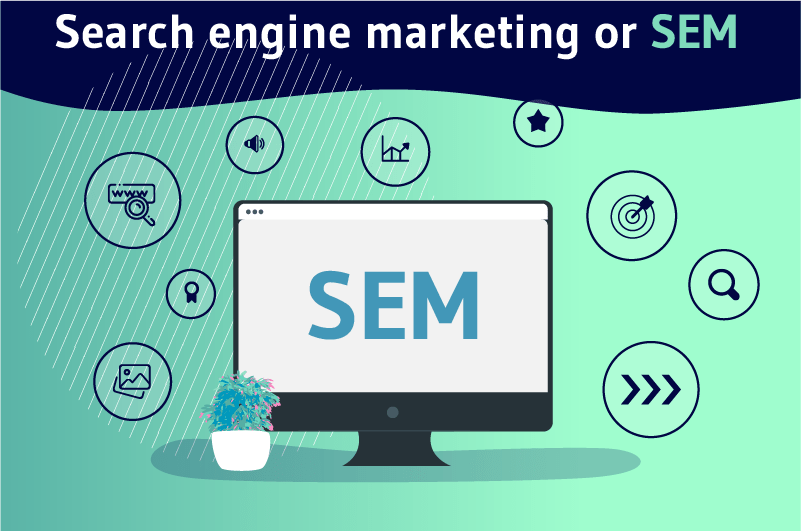


Very nice & impressive content.Good luck guys & team.
Very interesting to read the article.